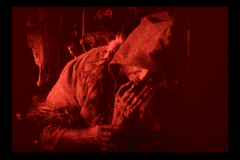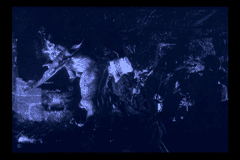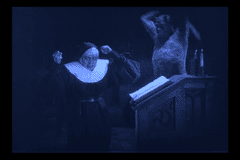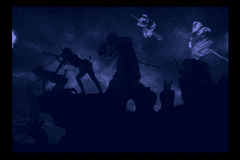Haxan (Benjamin
Christensen) 1922
 Filmed in 1922, Haxan, Benjamin
Christensen‘s witch documentary is an attention-grabbing and unique part of film history.
It is ostensibly a documentary, but the majority of the film is comprised of
dramatizations based upon historical facts. Clearly, the lines between fiction
and nonfiction film had not been as firmly established then as they are now. The
film opens with a lecture about the belief systems of pre-Renaissance times, and
how those beliefs fostered the creation of the witch myth. After about fifteen
minutes of this, however, the film launches into its longest segment: a staging
of one town’s visit from the traveling witch inquisition set in 1498.
Filmed in 1922, Haxan, Benjamin
Christensen‘s witch documentary is an attention-grabbing and unique part of film history.
It is ostensibly a documentary, but the majority of the film is comprised of
dramatizations based upon historical facts. Clearly, the lines between fiction
and nonfiction film had not been as firmly established then as they are now. The
film opens with a lecture about the belief systems of pre-Renaissance times, and
how those beliefs fostered the creation of the witch myth. After about fifteen
minutes of this, however, the film launches into its longest segment: a staging
of one town’s visit from the traveling witch inquisition set in 1498.
 This segment lasts nearly half of the film’s running
time, and it is filled with a startling sense of energy. The preceding chapter was
comprised of rather
straightforward documentary footage, which combined narrating intertitles with
shots of old illustrations and models. The dramatization doesn’t exactly shake
the narration, but the film seems to suddenly be more interested in entertaining
and titillating the audience. Several clear narratives emerge. A woman buys a
love potion from the local sorceress to seduce a pious man. A family, torn by
grief, accuses a beggar woman as a witch when their patriarch falls ill, only to
be later implicated themselves by her. A young friar begs to be whipped, so he
may cleanse himself of impure thoughts. The documentary setup seems to have been
created mostly to legitimize the morally dubious proceedings on display here. The film is clearly skewering
religion, showing it as a gluttonous boy’s club, and it’s only by claiming
to be the bearer of fact that it seems able to justify itself.
This segment lasts nearly half of the film’s running
time, and it is filled with a startling sense of energy. The preceding chapter was
comprised of rather
straightforward documentary footage, which combined narrating intertitles with
shots of old illustrations and models. The dramatization doesn’t exactly shake
the narration, but the film seems to suddenly be more interested in entertaining
and titillating the audience. Several clear narratives emerge. A woman buys a
love potion from the local sorceress to seduce a pious man. A family, torn by
grief, accuses a beggar woman as a witch when their patriarch falls ill, only to
be later implicated themselves by her. A young friar begs to be whipped, so he
may cleanse himself of impure thoughts. The documentary setup seems to have been
created mostly to legitimize the morally dubious proceedings on display here. The film is clearly skewering
religion, showing it as a gluttonous boy’s club, and it’s only by claiming
to be the bearer of fact that it seems able to justify itself.
 These scenes also show many sequences that speculate about
the witch’s behavior. These fantastical, effects-filled bits are one of the
film’s true highlights. Like Cocteau’s work, they manage to create a
legitimate illusion with the simplest effects. The Devil (played here by the
director!) is shown taunting and seducing the witches as they dance naked around
him. There’s a great deal of playfulness in these scenes, and it’s not
functioning only on a campy level. In the film’s 1941 re-release, it was
accompanied by an introduction by the director in which he says he feels the
silent film is much better than the sound film in creating a fantasy world.
After all, he says, who can create a voice for the Devil that surpasses that in
the viewer’s imagination. I think, to a degree, he is right. The film hasn’t
dated nearly as badly as one might suspect.
These scenes also show many sequences that speculate about
the witch’s behavior. These fantastical, effects-filled bits are one of the
film’s true highlights. Like Cocteau’s work, they manage to create a
legitimate illusion with the simplest effects. The Devil (played here by the
director!) is shown taunting and seducing the witches as they dance naked around
him. There’s a great deal of playfulness in these scenes, and it’s not
functioning only on a campy level. In the film’s 1941 re-release, it was
accompanied by an introduction by the director in which he says he feels the
silent film is much better than the sound film in creating a fantasy world.
After all, he says, who can create a voice for the Devil that surpasses that in
the viewer’s imagination. I think, to a degree, he is right. The film hasn’t
dated nearly as badly as one might suspect.
 The following segments show, respectively, a convent in
which a group of nuns have succumbed to the Devil’s madness, and the (ahem)
modern explanations for witchcraft. The scenes set in the convent are genuinely disturbing,
and comprise the film’s most successful sequence. The so-called possession
feels as if was born from the convent’s religious fervor, and the Devil seems a
convenient excuse for the nuns to end their repression. The modern day segment, which tries to
explain the witches’ behavior as a combination of sleepwalking and hysteria
hasn’t aged quite as well. Clearly, the average viewer today is better
equipped to explain the psychology behind the phenomena shown than an expert from
1922 was. Another aspect of
the film, from the director’s 1941 introduction, looks even more foolhardy in
retrospect. He asserts that the witch trials were humanity’s greatest tragedy,
but were also the result of an unenlightened, long-gone people. He suggests
nothing similar could happen in modern times, when the Holocaust proved that was
clearly not the case. Nonetheless, the film stands as a fascinating historical
document, and, more surprisingly, as a thoroughly watchable film.
The following segments show, respectively, a convent in
which a group of nuns have succumbed to the Devil’s madness, and the (ahem)
modern explanations for witchcraft. The scenes set in the convent are genuinely disturbing,
and comprise the film’s most successful sequence. The so-called possession
feels as if was born from the convent’s religious fervor, and the Devil seems a
convenient excuse for the nuns to end their repression. The modern day segment, which tries to
explain the witches’ behavior as a combination of sleepwalking and hysteria
hasn’t aged quite as well. Clearly, the average viewer today is better
equipped to explain the psychology behind the phenomena shown than an expert from
1922 was. Another aspect of
the film, from the director’s 1941 introduction, looks even more foolhardy in
retrospect. He asserts that the witch trials were humanity’s greatest tragedy,
but were also the result of an unenlightened, long-gone people. He suggests
nothing similar could happen in modern times, when the Holocaust proved that was
clearly not the case. Nonetheless, the film stands as a fascinating historical
document, and, more surprisingly, as a thoroughly watchable film.
* * * 1/2
November, 2001
Jeremy Heilman